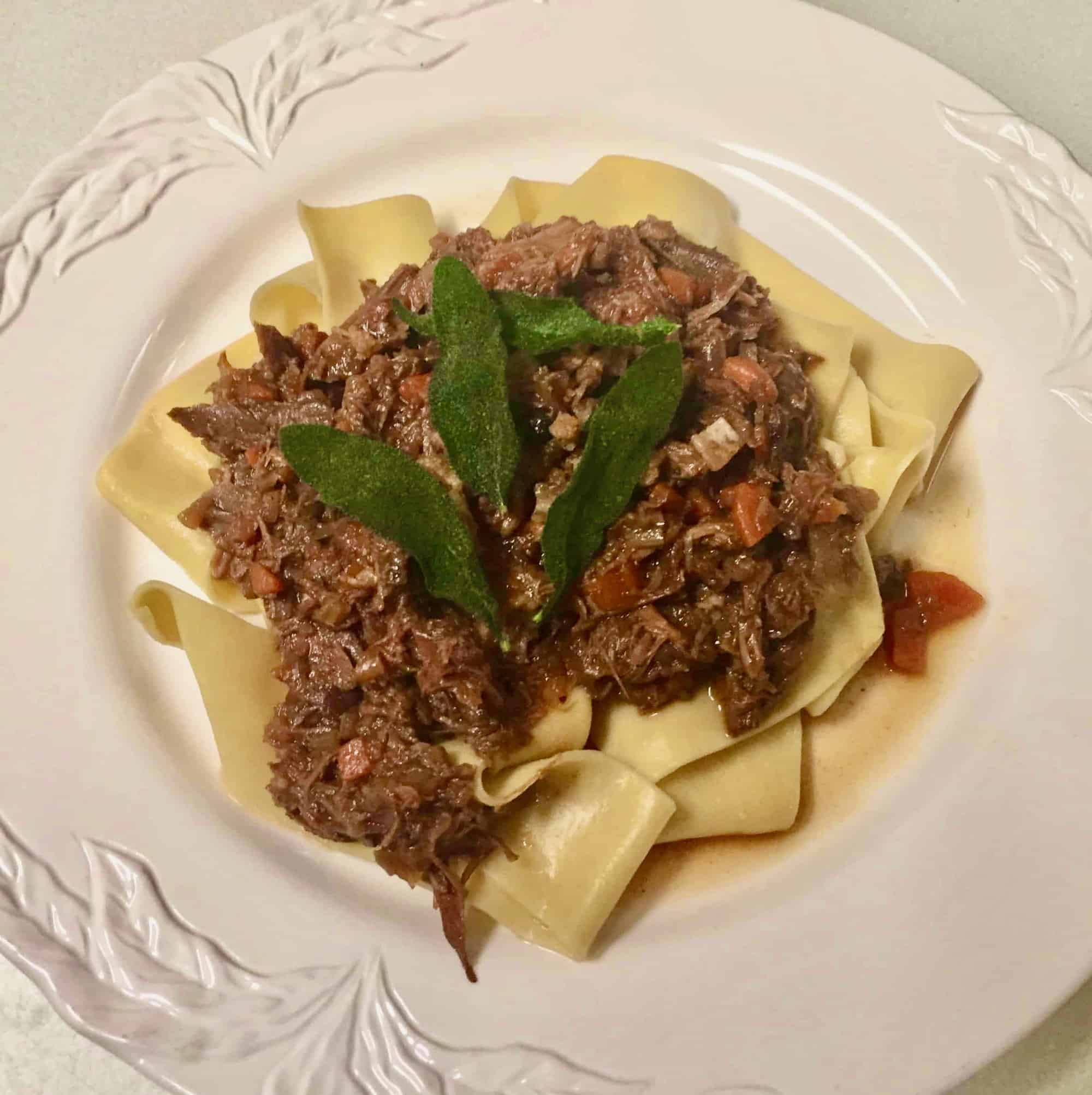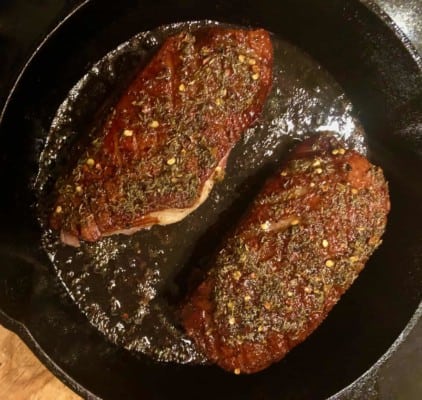 Sam Sifton is the Food Editor at The New York Times. If you aren’t a subscriber, you’d be astonished at his weekly output. Sometimes it feels as if his emails come hourly. Daily he extolls the virtue of various recipes that have appeared in the Times. He goes into “What To Cook This Weekend” mode on Fridays. And that’s where I found this recipe. It’s one of those dishes that those of us who love to cook love to cook when we’ve got an afternoon on our hands. And if it’s cold outside so much the better.
Sam Sifton is the Food Editor at The New York Times. If you aren’t a subscriber, you’d be astonished at his weekly output. Sometimes it feels as if his emails come hourly. Daily he extolls the virtue of various recipes that have appeared in the Times. He goes into “What To Cook This Weekend” mode on Fridays. And that’s where I found this recipe. It’s one of those dishes that those of us who love to cook love to cook when we’ve got an afternoon on our hands. And if it’s cold outside so much the better.

The recipe that Sifton developed was based on time he spent with Chef David Pasternack. The chef is partners with Joe Bastianich, his formidable mother, Lidia and Mario Batali in Esca, a restaurant on the fringes of the Theater District here in New York. Located at 402 West 43rd St. (Tel: 212 564 7272) it’s most famous for its fish. Frank Bruni, Sam Sifton’s predecessor as restaurant critic at the Times, described Pasternack as a ‘fish whisperer’, such is his  talent with all things maritime. The Great South Bay in the recipe title lies on the south shore of Long Island, between Fire Island and Jones Beach, stretching from there some 32 miles to the east. While its called a bay, it’s more properly a lagoon. Its shallow waters are shielded by barrier islands. Chef Pasternack is a devotee of the Bay and the day Sifton visited him, he was served a ragù that Pasternack had crafted from a couple of wild birds that someone had shot.
talent with all things maritime. The Great South Bay in the recipe title lies on the south shore of Long Island, between Fire Island and Jones Beach, stretching from there some 32 miles to the east. While its called a bay, it’s more properly a lagoon. Its shallow waters are shielded by barrier islands. Chef Pasternack is a devotee of the Bay and the day Sifton visited him, he was served a ragù that Pasternack had crafted from a couple of wild birds that someone had shot. 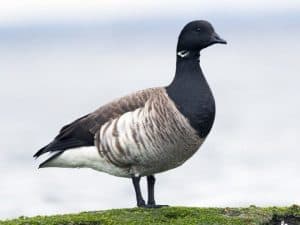 The Brant is actually a small goose which is native to these waters. It lives in the marshes and acquires the flavor to the small fish it subsists on. Pasternack called his dish “Brant Ragù”. Sifton described the dish as coming to the table “thick and dark, a kind of tomato jam knit together with heavy shreds of meat, riding a polenta raft: poultry that looked like pork and tasted of fish, a combination to reel the mind. It was food of deep intensity and flavor, and it led to crazy, vivid dreams, as wild food often does.”
The Brant is actually a small goose which is native to these waters. It lives in the marshes and acquires the flavor to the small fish it subsists on. Pasternack called his dish “Brant Ragù”. Sifton described the dish as coming to the table “thick and dark, a kind of tomato jam knit together with heavy shreds of meat, riding a polenta raft: poultry that looked like pork and tasted of fish, a combination to reel the mind. It was food of deep intensity and flavor, and it led to crazy, vivid dreams, as wild food often does.”
Sifton tasked himself with capturing the flavors with farmed duck. And to capture the briny flavor of the Brant, he enlisted the salty savory flavor of anchovies. Once incorporated to the stew, the anchovy all but disappears and becomes a umani element in the dish.
I used Moulard duck legs in mine. legs from my well-provisioned supermarket. Sifton says if you can get your hands on a mallard or canvasback, go for it. Anchovies and Juniper berries bring the hint of the bay in Pasternack’s original dish. Then there’s Red wine for body and red wine vinegar that cuts the richness of the duck. Whereas Sifton served his version on a bed of beautiful polenta, I chose to use fresh Pappardelle noodles with mine.

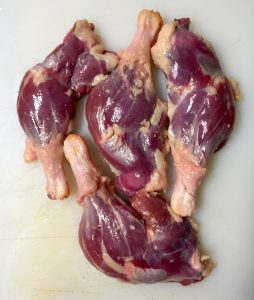 First, I removed the skin and as much of the fat from the legs as I could. Of course I kept the duck fat which makes the best fried potatoes ever. In a big heavy Dutch oven with a tight lid, I browned the duck legs. Once they were brown and crisp, I took them out of the pot. There was still enough fat on the bird that the mirepoix was flavored with it. Then, in a well in the middle of the softened vegetables, went the anchovies which broke up and melted. The juniper berries then the wine and the vinegar are added and the duck legs are re-introduced to the pot. Tomato paste follows and just enough chicken stock to almost cover the duck legs. There’s a nice long lazy cook and then you pull the legs from the pot, let them cool for a bit, then shred the meat and your Saturday night dinner is ready. I fried some sage leaves in duck fat for the garnish. Here is the recipe:
First, I removed the skin and as much of the fat from the legs as I could. Of course I kept the duck fat which makes the best fried potatoes ever. In a big heavy Dutch oven with a tight lid, I browned the duck legs. Once they were brown and crisp, I took them out of the pot. There was still enough fat on the bird that the mirepoix was flavored with it. Then, in a well in the middle of the softened vegetables, went the anchovies which broke up and melted. The juniper berries then the wine and the vinegar are added and the duck legs are re-introduced to the pot. Tomato paste follows and just enough chicken stock to almost cover the duck legs. There’s a nice long lazy cook and then you pull the legs from the pot, let them cool for a bit, then shred the meat and your Saturday night dinner is ready. I fried some sage leaves in duck fat for the garnish. Here is the recipe:
Great South Bay Duck Ragù
The perfect stew for a winter weekend, this dish is surprisingly light.
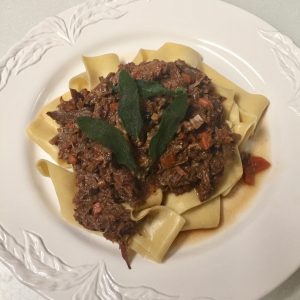
Ingredients
- 4 duck legs, trimmed
- 1 tablespoon olive oil
- 3 ribs celery, trimmed and cut into small dice
- 2 medium-size carrots, peeled and cut into small dice
- 1 medium-size red onion, peeled and cut into small dice
- 4 cloves garlic, peeled and minced
- 8 fillets of salted anchovy, rinsed, dried and minced
- 6 juniper berries
- 1 ½ cups dry red wine
- ½ cup red-wine vinegar
- 3 tablespoons tomato paste
- 2 cups low-sodium chicken stock
- 1 tablespoon minced fresh sage
- Kosher salt and freshly ground black pepper to taste
- 2 cups cooked polenta, for serving (optional)
- Or 12 oz. of fresh pappardelle cooked 2-4 minutes
Directions
- Step 1 Preheat oven to 350. Trim excess skin from duck legs and discard.
- Step 2 Heat a Dutch oven with a tightly fitting lid over medium heat. Add olive oil to the pot, and when it begins to shimmer, add the duck legs, skin side down. Cook until the skin is well browned and the fat has begun to render, approximately 8 to 10 minutes. Turn the legs over and brown the other sides, 5 to 10 minutes more. Remove to a plate to rest.
- Step 3 Add the celery, carrots, onion and garlic to the pot, and stir to combine. Cook until the onions have softened and have just started to color, approximately 8 to 10 minutes. Clear a space in the center of the pot and add the anchovies, then swirl them in fat until they begin to dissolve. Stir to combine. Add juniper berries, wine, vinegar and duck legs, and cook until most of the liquid has evaporated, approximately 15 minutes.
- Step 4 Add tomato paste and stir to combine, then enough chicken stock so that the combination takes on a sauce-like consistency and just covers the duck. Increase heat to high and bring to a boil. Put a lid onto the pot and place in the oven. Cook for 90 minutes, or until the legs are almost falling off the bone.
- Step 5 Remove duck from pot and allow to cool slightly. Peel off skin, dice and reserve. Shred meat off bones and return to pot. Place pot on stove top over medium heat and bring to a simmer. Add duck skin to taste, sage and salt and freshly ground black pepper to taste. Serve over polenta or pappardelle noodles
